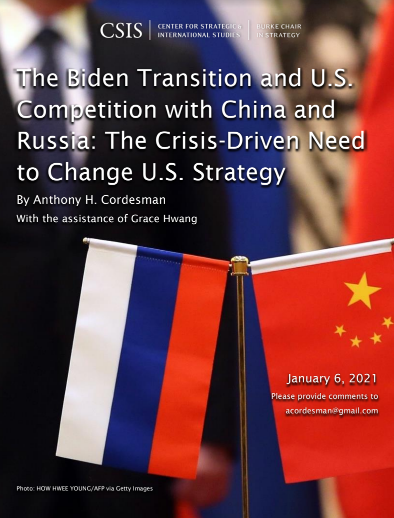Description
The U.S. needs to fundamentally reassess its approach to competing and cooperating with China and Russia. Its present path has tilted more and more towards a poorly structured approach to confrontation focused more on worst case wars than on the broader forms of military and civil competition the U.S. needs to address. It has failed to integrate civil and military competition, to address grey area operations, to look at the global nature of this competition, and to focus on the fact that most forms will either not involve direct combat or will do so at low levels of combat. It has not given the proper priority to address America’s strategic partnerships or to develop net assessments of the longer-term patterns in this competition.
This analysis addresses the failures in the current U.S. efforts to implement the new National Security Strategy and National Defense Strategy issued in 2017 and 2018, respectively. More broadly, it addresses the nuclear balance and the shortfalls in the U.S. approach to modernizing its strategic nuclear forces. It highlights the fact that the U.S. also cannot focus on major conventional combat with Russia and China or on combat at the theater level, and that most actual military competition will probably take place at the gray area, hybrid warfare, or irregular level.
It stresses the fact that the U.S. must compete on a global level as China and Russia will often compete indirectly and target U.S. strategic partners, other states, and non-state actors. This will require that the U.S. continues to deploy strong forces at major command levels in every region of the world, and especially in Europe, the Middle East, and Asia. The strategic partnerships between these U.S. commands and key allied states will determine both the overall patterns of U.S. success, and they will be critical to deterring and defending against escalation to major conflicts and nuclear war.
It notes that U.S. strategic partnerships must also evolve to create interoperable conventional forces that can actually implement what has come to be called Joint/All-Domain Warfare, and it will compete with Chinese and Russian rates of modernization, force improvements, and changes in operational range and tactics.
At the same time, the analysis focuses in depth on the civil side of competition, and the fact that both China and Russia – and especially China – integrate military and civil competition at every level, including the development of their international trade and investment, their national technology base, as well as their political and diplomatic efforts. These are areas the U.S. needs to give far more attention, along with the need to compete in information warfare and at the pubic diplomatic level.
 العربية
العربية  English
English 




